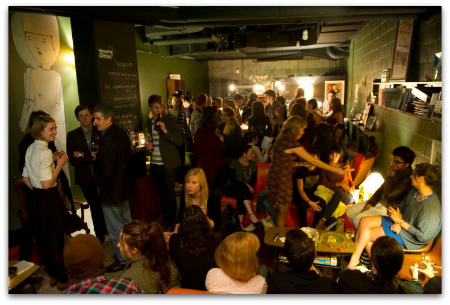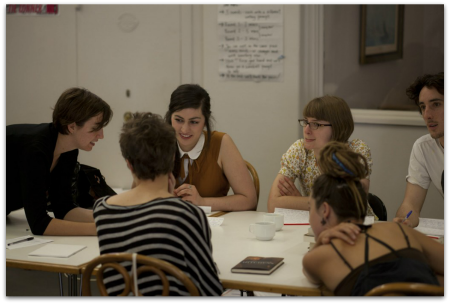Recently, Robyn Annear wrote an article for The Monthly which queried the purpose of Australian literary journals. In her opening remark she asked whether these publications were the hallmarks of a thriving scene or playgrounds for emerging writers. Later, she commented: ‘Depending wholly on sales and subscriptions would seem to be no way for a literary magazine to thrive.’
Such a statement brings to mind Matthew Lamb’s (editor of Island magazine) excellent and thought-provoking interview with the Wheeler Centre. In the interview Matthew suggested that writers should be responsible for supporting these journals that, in turn, are supporting them. Stuart Glover (editor of Bumf) took a similar approach on his blog, additionally suggesting that the ‘government and institutions investing in little magazines should see them principally as ways to find and develop new writers’.
All of these things - sustainability, purpose, readership - are issues I’m constantly negotiating in relation to a literary project I help run called Stilts.
Some friends and I formed the project a few years ago. At the time we were all living together in a share house in Brisbane and to us, it felt like the city was missing something. After attending a Women of Letters event - the one where Michelle Law made everyone cry - we went out to dinner and queried why this kind of event didn’t seem to happen more often in our city. We became fixated on our belief that a lot of writers we knew were lacking exposure, simply because our home state lacked what we perceived as the bustling industry and government support of Melbourne and Sydney.
Whether this belief was justified or not, when we published our first issue of the Stilts journal (a publication dedicated to promoting writers solely from Brisbane) the response was overwhelmingly positive.

The crowd at our first journal launch.
Of course, if you’re not from Brisbane and you’re not involved in the literary scene, you’ve probably never heard of us. Yet, for the people engaged in that particular world at that time, I genuinely think we provided something they wanted. From the beginning, we never intended to be just a journal - we recognised there were limitations on what we could achieve as a small, self-funded group if we restricted ourselves in this way. For us, being multi-platform was something that seemed necessary if we wanted to survive past a first issue, and besides, it broadened our scope for project planning.
So, we also created a website, ran events and began to collaborate with other people who had ideas we liked. Through all these platforms, we promoted people we thought deserved to be read. For some of them, Stilts was their first publication or their first time reading their work to an audience. Some were contacted by other places after being published on our website and others went on to be nominated for prizes. A couple of writers we published in our journals went on to get book deals. (Our second issue includes an excerpt of Michelle Dicinoski’s memoir Ghost Wife, for example.)
Which brings me back to Annear’s article. At one point she comments that the absence of literary magazines would ‘discommode contributors, and potential contributors, far more than it would readers’. I agree here but I also have to say that I don’t think this is necessarily a problem. It’s likely that Stilts was only influencing those occurrences I mentioned above indirectly. (I am a believer that if you’re creating good writing, you will find a home for it eventually regardless of what your writing CV says.) But I also believe that you can’t underestimate how personally empowering a sign of encouragement can be for anyone who works in creative practices. We’re always hearing stories about writers who never gave up despite constant rejection, but I think a lot of those people had a support network of some kind. This was, and remains, one of the central purposes of what Stilts is and it’s one I feel good about.
Yes, ultimately I want as many readers as possible. I think you should read Sarah Kanake’s short fiction, ‘the road runs on’, and Rebecca Jessen’s memoir, ’Into the groove’ - and I don’t want you to do this out of a duty to support literature, but because these pieces are great and because they moved or interested me. And from what I know of other people involved with small press, I think this feeling is universal.
Since that first journal launch, a lot has changed. For one thing, family and work commitments took the Stilts team down to Melbourne, so it is here that the project is now based. For another, so many more projects now happen in Brisbane including two new online journals (Bumf and Scum Mag) and a really amazing bi-monthly storytelling night called Yarn: Stories spun in Brisbane. Next door, the Gold Coast also now have Rabbit + Cocoon, a creative precinct that provides spaces and resources for motivated people to run creative practices, businesses and events. If we still lived in Brisbane, I don’t know if we’d feel that same need to start our own publication.
Being in Melbourne comes with its own problems. The market is crowded and being removed physically from Brisbane, we couldn’t commit to our original purpose. We’ve had some very serious conversations about this, ones where our central question was invariably - how can we adapt to our new situation? Because as it turns out, the real advantage of being independent and self-funded is having the freedom to change, to be flexible in what we decide.
So we broadened our focus to a national scale and began reaching out to collaborate with different kinds of projects; with other journals we enjoy reading, such as The Lifted Brow; and events which we’re exciting about, such as The Emerging Writers’ Festival.

Writing workshop at NYWF 2013 with
We extend this same flexibility to our journals. Each time we sit down to plan our next issue we toss around themes and ideas. The format and focus varies from issue to issue. Our editor Katia Pase places particular importance on this transformative nature, stating that it ensures ‘each issue is relevant, valuable, and unrestricted by what has already been done’. The issue we’re currently producing will include only four pieces of long-form writing (6000-8000 words). By setting these parameters, our hope is to not only publish pieces that are an unusual length for Australian writing currently, but also to give our four contributors more space to breathe, and to signal a return to slow reading that our website can not (and perhaps should not) accommodate.
Running this project has been such a massive learning curve - and perhaps selfishly - this is for me one of the other reasons why Stilts continues to exist. Looking back to Annear’s initial question, I’d argue that many journals are indeed playgrounds for emerging writers - and also editors, project managers, policy changers and more. And it’s exciting to be part of this community.
If you want to read more about


